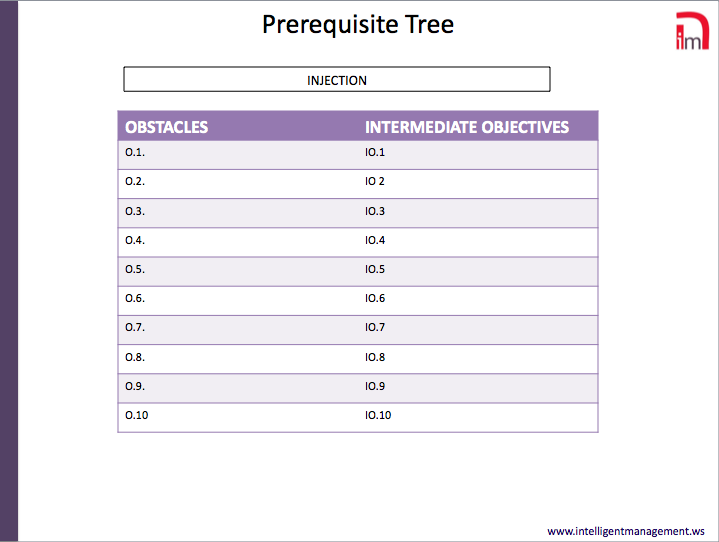 When we face the ordeal of achieving an ambitious target we are often daunted by the ‘mountain’ we have to climb. How can we successfully overcome the obstacles?
When we face the ordeal of achieving an ambitious target we are often daunted by the ‘mountain’ we have to climb. How can we successfully overcome the obstacles?
Dr. Domenico Lepore, international expert in systemic and sustainable management, continues his series on the Thinking Process Tools from the Theory of Constraints.
Deploying the strategy: the tools
So far, we have looked at building the Core Conflict of an organization that allows us to verbalize what is preventing the organization from achieving more towards its goal. Once we have identified the core constraint, or cognitive constraint, we are able to derive the solutions (injections) to move the organization forward towards its stated goal. Now we need to deploy the strategy.
The Prerequisite Tree (PRT) and the Transition Tree ( TRT) have been designed to gather and deploy all the knowledge needed to achieve the solutions (injection) identified in the Future Reality Tree (FRT). The Prerequisite Tree and the Transition Tree are the backbone of an actionable plan. They pursue the goal of providing guidance and a logical pattern as well as detailing all the steps that have to be taken in order to achieve the stated objective. Let’s see how they work.
Leveraging the unknown
When we face the ordeal of achieving an ambitious target we are often daunted by the ‘mountain’ we have to climb; all we see are the obstacles in front of us. We perceive these obstacles as undefined, scary entities that hinder our ability to achieve our goal. When we are in front of an injection (or any other arduous task) the first reaction is: “Oh my goodness, how am I going to do this?” This is understandable but it is not rational. First of all, why are we faced with this feat? Because either we have chosen to be, or because it is part of an evolution, personal and/or organizational, we have decided to be part of. Very rarely do we get ourselves in front of a task we have no possibility of overcoming. Indeed, at the onset, we might not have clear ideas on how to tackle the ordeal. This is good, let’s leverage it.
The basic raw materials to build a core conflict are Undesirable Effects (UDEs); the starting ingredients for a Prerequisite Tree are the obstacles we envisage in our journey to the goal: let’s list them. The writing of this list is going to be both liberating and informative: we shall have full clarity of what we perceive as an impediment and with it we’ll develop a pacifying sense of control over it. When the list is complete we will have split “a big and undefined problem” into a set of much smaller ones. How do we attack them? We make a list of the obstacles on the left side of the page, from top to bottom; then on the same line on the right side of the page we can list a corresponding Intermediate Objective. An Intermediate Objective can be either a logical statement describing what would enable us to overcome that obstacle or, better, how we intend to do it. For instance, if the obstacle is “I have insufficient funds” the Intermediate Objective could either be “I have provided for sufficient funds” or, better, the solution, i.e. “I have persuaded my aunt to sponsor me”.
How to cause the change – obstacles along the road to change
In order to build the Prerequisite Tree, we start by listing all the obstacles we see preventing us from implementing the injection.

Now that we have the solution, i.e. the Intermediate Objectives (IOs), to the individual obstacles (very often one I.O. addresses several obstacles) we can forget about the obstacles and concentrate on the Intermediate Objectives. The next step is to provide a basic sequence to these IOs. This is for two reasons: first, we need to ascertain “what is prerequisite to what”; second, we need to know how many things we could theoretically run in parallel. (In reality, resources will dictate that pace, as we will see).

In our next post we will look at the tool that allows us to break down the Intermediate Objectives into actionable, logically tested steps.
Extract from the book:
Sechel: Logic, Language and Tools to Manage any Organization as a Network
See also:
Separating Wants from Needs: Tools for Thinking Systemically
Connection and Transformation with the Conflict Cloud Tool
How Control Vs. Vision Leads to Breakthrough with the Core Conflict Cloud
Challenging the Mental Models of Organizations with the Core Conflict Cloud
Designing A Desirable Future for an Organization: the Future Reality Tree
What Do We Mean When We Talk About the Future?
Making Management Meaningful
Thinking Process Tools for Managing Systemically
Change: Tools for Thinking, Planning and Enacting Change
Training Sessions to learn these Tools





Leave a Reply